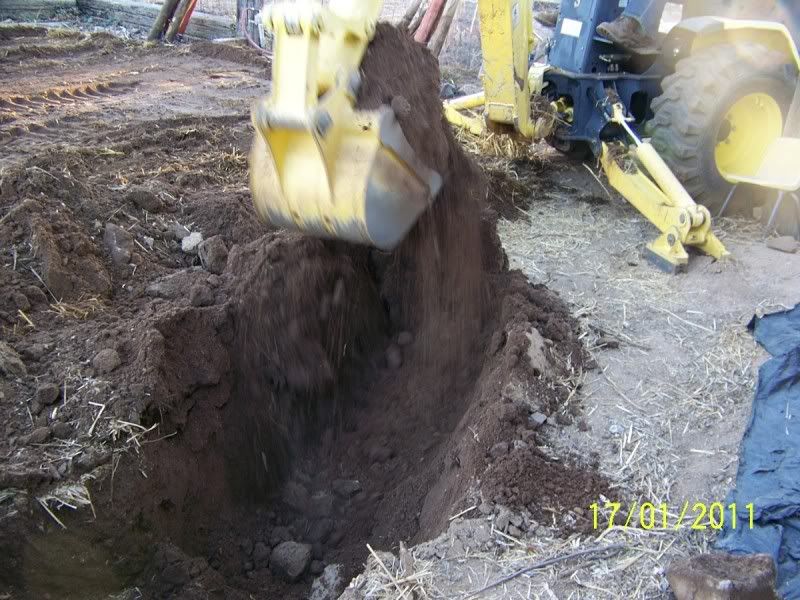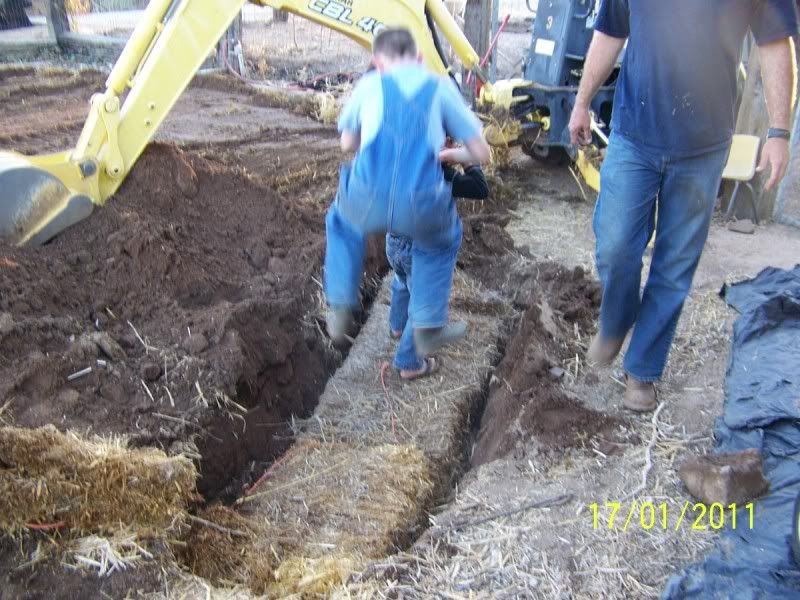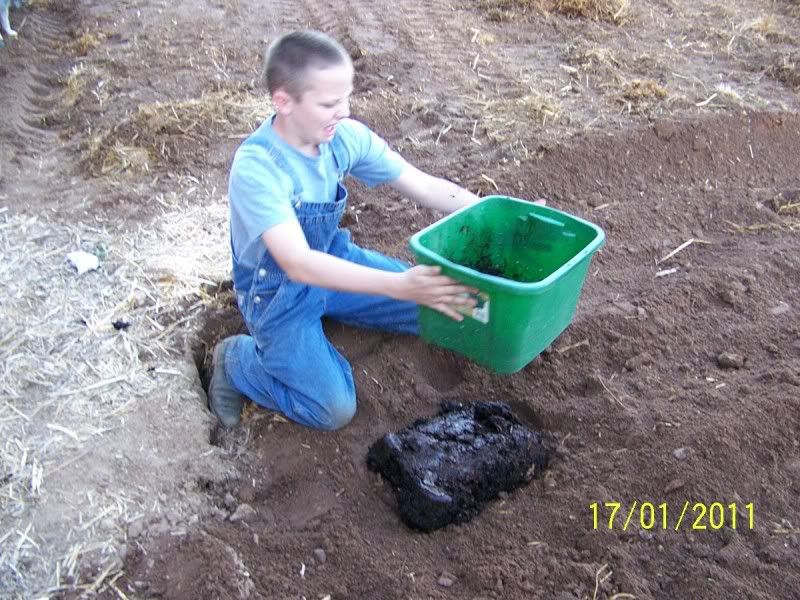

|
A garden is only as good as the ground that it's planted in. Discussion forum for the many ways to improve the soil where we plant our gardens.
|
 |
|
|
Thread Tools | Display Modes |
|
|
#16 |
|
Tomatovillian™
Join Date: Oct 2007
Location: Tucson, Arizona (catalina)
Posts: 413
|
Just a note, watch the postings locations.
Here in Southern Arizona, 6 to 10 inches of composted horse manure per year is adequate for organic renewal of my soil. It is devoid of organic material and worms. This is the third year in a virgin soil and we are excited about being able to find worms this year about every two or three shovels turned over. When I lived in Oklahoma in a river bottom, we only needed an inch or so every year for all its needs and no supplemental trace elements. good luck and remember this is fun.... LOL. 
__________________
Hangin on for dear life! |
|
|

|
|
|
#17 | |
|
Tomatovillian™
Join Date: Jun 2011
Location: Louisiana
Posts: 587
|
Quote:
http://lancaster.unl.edu/hort/articl...soiltest.shtml |
|
|
|

|
|
|
#18 | |
|
Tomatovillian™
Join Date: Aug 2011
Location: Nebraska
Posts: 81
|
Would it be worth the investment of time and money to get a worm farm to have my own worm castings? I've heard how they are very beneficial for the soil and, additionally, will actually draw more worms to the areas where the castings are applied.
Quote:
__________________
Shannon 
|
|
|
|

|
|
|
#19 |
|
Tomatovillian™
Join Date: Oct 2007
Location: Tucson, Arizona (catalina)
Posts: 413
|
here is what we did in the corner of the garden and a year later it seems to be working. we didn't have to do this in our Oklahoma garden, but out here drastic means had to be taken to keep the little worms happy!
    the grandkids helped put a couple of old moldy bales of straw in the corner of the garden and a wheelbarrow of fresh manure on top before covering with soil, we have since used this spot to put the compost pile of horse manure. 
__________________
Hangin on for dear life! |
|
|

|
|
|
#20 |
|
Tomatovillian™
Join Date: May 2006
Location: Rock Hill, SC
Posts: 5,346
|
An earthworm test is to dig up a square foot of soil and count the number of earthworms.
Note that adding earthworms to soil doesn't give any long-term benefit. If the soil is good enough, earthworms will be attracted to it by themselves. If the soil isn't appealing to earthworms, then any you add will leave almost immediately.
__________________
[SIZE="3"]I've relaunched my gardening website -- [B]TheUnconventionalTomato.com[/B][/SIZE] * [I][SIZE="1"]*I'm not allowed to post weblinks so you'll have to copy-paste it manually.[/SIZE][/I] |
|
|

|
|
|
#21 |
|
Tomatovillian™
Join Date: Oct 2007
Location: Tucson, Arizona (catalina)
Posts: 413
|
feldon that may be a good general rule, but there are different soils that don't hold wigglers and I a lot of the arid soils here in the Southwest don't and won't hold them. It has taken two years of organic additives aka.. horse poop. to get the soil to the point where it will hold worms. Worms and growth of my maters is what helps me determine when enough is enough. I've never seen large earth worms around here due to the intense heat and depleted, alkaline soil, but with regular irrigation and lots of mulch we can get the red wigglers to live. If now, the third year, my production and taste is as expected I can at least back off and only add a few inches of compost next year. These pits are good when quit irrigating and if worms die off then there is always that resource and they will return again with regular irrigation and more additives.
 If I had the resources, I would simply get regular soil tests, but with my sustainable gardening this works with little cost in and a lot of value out. Its also a great place for the grandkids to find worms for our fishing trips..
__________________
Hangin on for dear life! |
|
|

|
|
|
#22 |
|
Tomatovillian™
Join Date: Jan 2007
Location: PNW
Posts: 4,743
|
This post (to a permaculture mailing list) gives you a good
picture of what is going on with the roots down under the soil surface: http://lists.ibiblio.org/pipermail/p...ry/007522.html
__________________
-- alias |
|
|

|
|
|
#23 |
|
Tomatovillian™
Join Date: Oct 2007
Location: Tucson, Arizona (catalina)
Posts: 413
|
good article dice, I have a vague understanding of cover crops and not the academic complexities, strictly trial and error here, i've started using cover crops during the summers here .. mostly alfalfa, buckwheat, vetch and cotton. I've wanted some of the ones that will penetrate my rockhard subsoil. I don't have good drainage. I have a friend at the UofAz ag dept and he has told me the need for cover crops and organic material. I wasn't aware of the fine root hairs dying off during short saturation, interesting. The first year very little grew, the second year 10', I got a few good veggies and in 11' we got a good harvest from most veggies. Each year we just planted between rows and buckwheat, alfalfa and cotton grew well. I just covered everything with a thick layer of compost last week and am hoping for a normal year in 12' compared to past experience. I am so thankful for this forum. Even an old dog can learn new tricks. When I was a kid my grandpa did what I'm doing and now I wish I had listened better ... LOL. thanks.
__________________
Hangin on for dear life! |
|
|

|
|
|
#24 |
|
Tomatovillian™
Join Date: Jan 2007
Location: PNW
Posts: 4,743
|
I have winter-dormant alfalfa and a cold-tolerant clover in the paths,
and then I plant winter rye, hairy vetch, and bell beans in the rows in late summer. (The vetch, in particular, needs to be planted while the soil is still warm enough for it to sprout.) Sometimes that is a little too early for the bell beans. I had them grow up and flower before first frost in 2010, and then the first snow killed most of them. Oh well, winter mulch. Besides alfalfa, Peaceful Valley lists Birdsfoot Trefoil, Chicory, oilseed radish, and canola as plants with deep tap roots that will penetrate compacted subsoil (also Sun hemp and Sesbania, but those are toxic to livestock and Sun hemp is toxic to fowl, too). Mustards have serious root systems, too, for breaking up compacted soil and adding organic matter.
__________________
-- alias |
|
|

|
|
|
#25 |
|
Tomatovillian™
Join Date: Oct 2007
Location: Tucson, Arizona (catalina)
Posts: 413
|
I read some article this summer about certain varieties of mustard being a good cover crop and dropping deep roots. I also planted daikon radishes all over the garden this past summer and just left them and covered them with compost. I don't know yet, but the vetch and alfalfa along with some of the other stuff will probably come up through the compost this spring.. I plan on only turning the rows over with a shovel before planting and not tilling, totally new ground for me. I let the buckwheat go to seed before pulling it and just left the seed on the ground. I'm trying to only plant cover crops that the horses won't get sick on. My granddaughter likes harvesting and feeding it fresh to the horses.
__________________
Hangin on for dear life! |
|
|

|
|
|
#26 | |
|
Tomatovillian™
Join Date: Jan 2007
Location: PNW
Posts: 4,743
|
Quote:
keeps the soil from being compacted by rain and full of roots that will decay after the annual cover crop in the rows dies off. If everything was pretty much dead by mid-winter (too cold), then I will spread decaying leaves, compost, bales of alfalfa, and/or horse manure over the parts with nothing growing in it and turn it over with a shovel before planting. (The less work the better.:-)
__________________
-- alias |
|
|
|

|
|
|
#27 | |
|
Tomatovillian™
Join Date: Feb 2010
Location: zone 5
Posts: 821
|
Quote:
My best advice is that the easiest way to go organic, is to not supplement the purchase of a lot of chemical stuff with the purchase of a lot of organic stuff. Instead shred the leaves in your yard, compost your veggie and egg shell waste and little twigs. Call around to local stables, especially park district ones and see if they give away free composted manure. (Note, horses get treated with meds, so the addition of their poop is not technically organic.) Check out vermicomposting, learn about compost tea. Walk thru the garden daily for hand picking of jap beetles. Consider row cover over young cukes and pumpkins and melons. Rotate your crops. Don't tromp on your soil. Drain the fish tank into the garden. etc etc etc. For this year, grow the crops in places you haven't had their type before. The soil there is less likely to be depleted with what they need. Going organic can get really expensive, but it doesn't need to. I've been gardening mostly organically for years. The only thing I buy to do it is a bit of Neptunes from time to time.  Good luck and Welcome to the less toxic side.  Stacy |
|
|
|

|
|
|
#28 |
|
Tomatovillian™
Join Date: Oct 2007
Location: Tucson, Arizona (catalina)
Posts: 413
|
Stacey, I agree with you, for my needs... I only garden 2000sq ft for hobby and family food and don't spend (won't spend, can't spend)a lot of money on fertilizers.. that said I've always used manures and compost, but about 5years ago in a new virgin soil garden I started using less chemical fertilizers and was impressed with the way the soil balances itself and the plants were definitely healthier. Our soil tests cost close to a hundred dollars here in this area, so I refused to spend that much. Recently like I told dice, I have gone completely organic and am trying the no till this year and am excited to see the results .... the only cost will be my 25lb bag of fishbone meal I love, for about 38dollars for a two or three year supply, fish liquid, molasses, and a few others that last me a few years each. We have two horses and a couple dozen chickens and this has proved to be more than adequate for a sweet loose soil as it builds up year over year. As soon as the top soil gets deeper, I will back off on the thickness of compost each fall, but for now the massive amounts of compost is needed as the garden is only 3 years old and was an old driveway with a few cactus growing there.

__________________
Hangin on for dear life! |
|
|

|
|
|
#29 |
|
Tomatovillian™
Join Date: Jan 2007
Location: PNW
Posts: 4,743
|
I have a bed that had a 100-year fir tree in it where the tree fell over
and the stump was removed. It was basically glacial till, clay with some gravel in it. The first year I mixed in a few inches of peat moss all over it, sprinkled dolomite lime and K-mag (sulphur-magnesium-potassium in a slow-release, water soluble rock form) around on it and dug that in, then dug 5-gallon bucket sized holes for each tomato plant and filled them with a mixture of compost and horse manure. The next winter I grew a cover crop of winter rye. I mowed it once it flowered with a hedge trimmer, saved the top growth for mulch, and turned over the stubble. That year I reduced the per-plant holes to 3 gallons and filled them again with a mix of compost and horse manure. I spread the mowed winter rye top growth back over it for mulch. The next winter I grew a mix of bell beans and hairy vetch for a cover crop. I mowed that the next spring when the vetch flowered, and just turned the top growth back into the soil. I mulched with leaves and sprinkled "Compost maker" (a 4-3-3 organic fertilizer, basically) around on it. The per plant holes stayed at 3 gallons, but I was out of horse manure, so I just used compost in them, and I top-dressed in a little circle around the plants with Tomato-tone and cultivated it into the top few inches of soil. The next year I had minimal winter cover crop (most of it died in cold weather), so in spring I spread a bale of alfalfa around on it and turned it under with a shovel. The per plant holes got down to 2-gallons of compost, and I again used Tomato-tome or some equivalent (Plant-tone, maybe) in a little circle around each plant. The next winter's cover crop was so-so, so I spread a bale of straw over it in spring, sprinkled rock phosphate and greensand around on it, and covered it with an inch of compost with some sand in it. I did not bother to turn this under, just let it rot on top of the soil. I stuck with the 2-gallon per-plant holes, but this time I mixed vetch top growth from the winter into them instead of compost (breaks down fast). I mulched with leaves, and I watered each plant with some compost tea to help the vetch top growth break down. As the years passed, that is what I kept doing, growing winter cover crops to put roots in the soil and adding a layer of organic matter in spring. If the winter cover crop was good, the mowed part of it is enough, and I do not need to add anything else to it. It has a couple of feet of fertile topsoil on top, and the per-plant holes are down to 1-gallon. Now I add a handful of fertilizer in the hole, organic stuff If I have it or some generic 5-10-10 if I do not, mix it up with the dirt, and either use mowed cover crop top-growth or compost and mix it into the dirt that I fill the hole back up with after transplanting. (The clover and alfalfa in the paths is pretty much "as good as compost" to mix into the soil around a transplant, and I only need to plant new winter cover crop each year where tomato plants or ground cherries or whatever were actually growing, instead of over the whole bed.) Every year I spread some gypsum around on it to supply calcium, about every third year I use dolomite lime instead, and about every 5 years I sprinkle rock phosphate and greensand on it. (The rock phophate will not wash into the soil, so it needs a layer of dirt or mulch or something on top, so the roots and mycorrhizae will find it. It does not need to be very thick, though.) So it went from "fill dirt" to "topsoil fit for a garden, with plenty of organic matter" in about 5 years. If I get a load of horse manure (or rabbit, or llama or alpaca), I just spread that around on top now and cover it with an inch of dirt or compost, and mix some into the compost pile. If you have tree leaves around, that reduces what you need to buy to build up organic matter in the soil. You can spread them in fall and turn them under in spring at first, also mulching with them over the summer. After a few years you can skip turning them under and just pile them up on the soil every fall. Deer Park in Texas uses leaves as the only annual input. Earthworms do the rest. Plant nutrients in municipal leaves (ask if they have been sprayed for anything if they are not from your own trees): http://www.spectrumanalytic.com/supp...pal_Leaves.htm edit: Stay away from ash and walnut leaves. Those trees produce juglone, a chemical with which tomatoes and other vegetables do not get along: http://en.wikipedia.org/wiki/Juglone
__________________
-- alias Last edited by dice; January 31, 2012 at 01:56 PM. Reason: juglone |
|
|

|
|
|
#30 |
|
Tomatovillian™
Join Date: Oct 2007
Location: Tucson, Arizona (catalina)
Posts: 413
|
Yeah, 5years has been my experience also... I'm in the third now and crops are getting reasonable size and production... I love to use leaves, but none here ... our mesquite leaves are tiny and blow away in the wind... its funny you mention digging holes... I did that last year for my squash and had as good a crop of summer and winter squash as I've ever had. Even very little disease although I water twice a day when the temps get over 100. I may try that for my maters this year and see how they do.
__________________
Hangin on for dear life! |
|
|

|
 |
|
|
